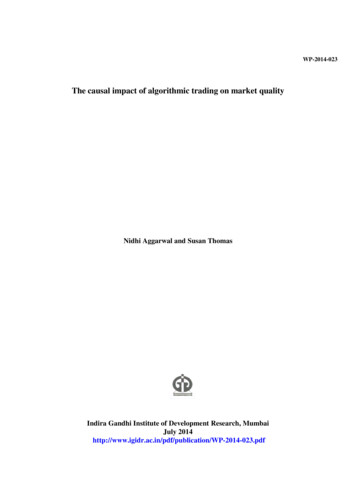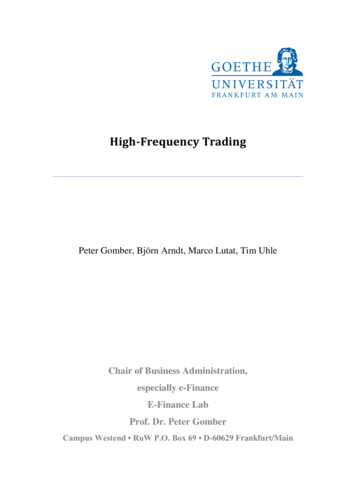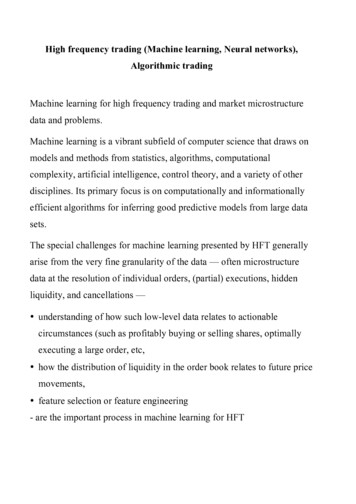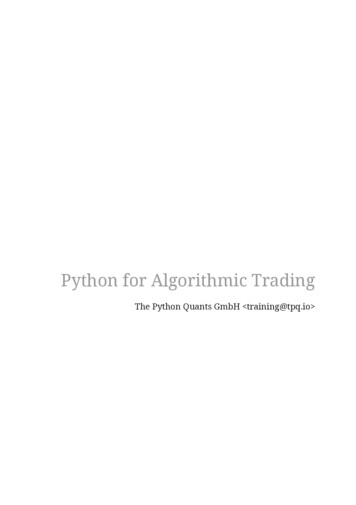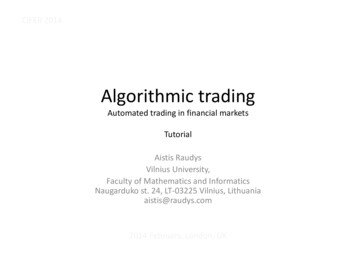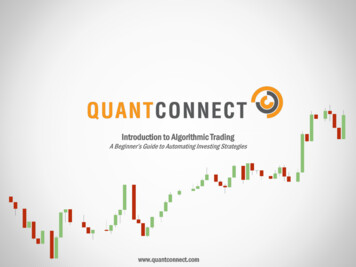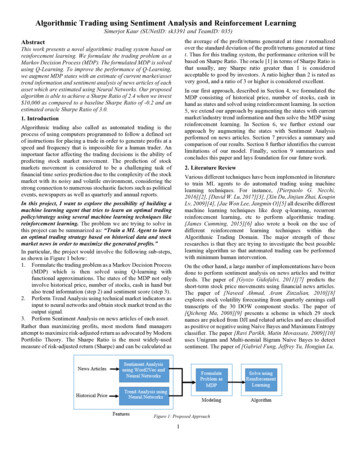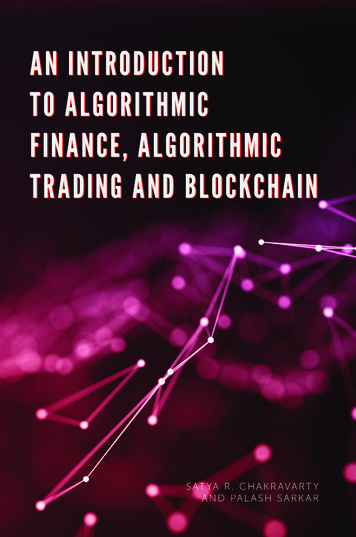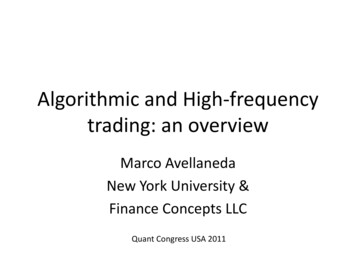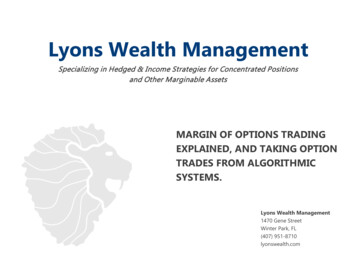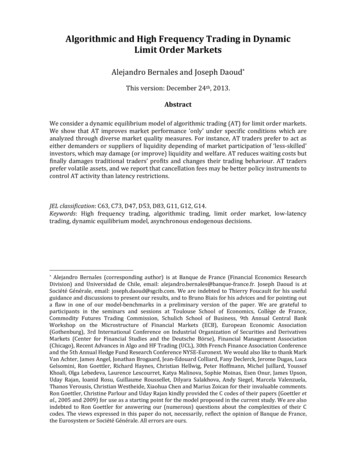
Transcription
Algorithmic and High Frequency Trading in DynamicLimit Order MarketsAlejandro Bernales and Joseph Daoud*This version: December 24th, 2013.AbstractWe consider a dynamic equilibrium model of algorithmic trading (AT) for limit order markets.We show that AT improves market performance ‘only’ under specific conditions which areanalyzed through diverse market quality measures. For instance, AT traders prefer to act aseither demanders or suppliers of liquidity depending of market participation of ‘less‐skilled’investors, which may damage (or improve) liquidity and welfare. AT reduces waiting costs butfinally damages traditional traders’ profits and changes their trading behaviour. AT tradersprefer volatile assets, and we report that cancellation fees may be better policy instruments tocontrol AT activity than latency restrictions.JEL classification: C63, C73, D47, D53, D83, G11, G12, G14.Keywords: High frequency trading, algorithmic trading, limit order market, low‐latencytrading, dynamic equilibrium model, asynchronous endogenous decisions.* Alejandro Bernales (corresponding author) is at Banque de France (Financial Economics ResearchDivision) and Universidad de Chile, email: alejandro.bernales@banque‐france.fr. Joseph Daoud is atSociété Générale, email: joseph.daoud@sgcib.com. We are indebted to Thierry Foucault for his usefulguidance and discussions to present our results, and to Bruno Biais for his advices and for pointing outa flaw in one of our model‐benchmarks in a preliminary version of the paper. We are grateful toparticipants in the seminars and sessions at Toulouse School of Economics, Collège de France,Commodity Futures Trading Commission, Schulich School of Business, 9th Annual Central BankWorkshop on the Microstructure of Financial Markets (ECB), European Economic Association(Gothenburg), 3rd International Conference on Industrial Organization of Securities and DerivativesMarkets (Center for Financial Studies and the Deutsche Börse), Financial Management Association(Chicago), Recent Advances in Algo and HF Trading (UCL), 30th French Finance Association Conferenceand the 5th Annual Hedge Fund Research Conference NYSE‐Euronext. We would also like to thank MarkVan Achter, James Angel, Jonathan Brogaard, Jean‐Edouard Colliard, Fany Declerck, Jerome Dugas, LucaGelsomini, Ron Goettler, Richard Haynes, Christian Hellwig, Peter Hoffmann, Michel Juillard, YoussefKhoali, Olga Lebedeva, Laurence Lescourret, Katya Malinova, Sophie Moinas, Esen Onur, James Upson,Uday Rajan, Ioanid Rosu, Guillaume Roussellet, Dilyara Salakhova, Andy Siegel, Marcela Valenzuela,Thanos Verousis, Christian Westheide, Xiaohua Chen and Marius Zoican for their invaluable comments.Ron Goettler, Christine Parlour and Uday Rajan kindly provided the C codes of their papers (Goettler etal., 2005 and 2009) for use as a starting point for the model proposed in the current study. We are alsoindebted to Ron Goettler for answering our (numerous) questions about the complexities of their Ccodes. The views expressed in this paper do not, necessarily, reflect the opinion of Banque de France,the Eurosystem or Société Générale. All errors are ours.1
Algorithmic and High Frequency Trading in DynamicLimit Order MarketsAbstractWe consider a dynamic equilibrium model of algorithmic trading (AT) for limit order markets.We show that AT improves market performance ‘only’ under specific conditions which areanalyzed through diverse market quality measures. For instance, AT traders prefer to act aseither demanders or suppliers of liquidity depending of market participation of ‘less‐skilled’investors, which may damage (or improve) liquidity and welfare. AT reduces waiting costs butfinally damages traditional traders’ profits and changes their trading behaviour. AT tradersprefer volatile assets, and we report that cancellation fees may be better policy instruments tocontrol AT activity than latency restrictions.JEL classification: C63, C73, D47, D53, D83, G11, G12, G14.Keywords: High frequency trading, algorithmic trading, limit order market, low‐latencytrading, dynamic equilibrium model, asynchronous endogenous decisions.2
1IntroductionFinancial markets have undergone a major technological transformation during the pastdecade: from human‐led transactions to algorithmic trading (henceforth, AT), in whichsophisticated computers quickly process information, and algorithms automatically submitand modify orders utilizing superfast connections to the exchanges. However, this financialinnovation has generated a relatively favourable position for investors with algorithmictrading features, over the rest of the market participants. On the one hand, algorithmic tradershave an 'informational advantage' since AT technology allows fast access and quick analysis ofmarket information. On the other hand, algorithmic traders have a 'trading speed advantage'since they have a low‐latency transmission of orders.1 Currently, there is a growingtheoretical literature on understanding the impact of AT on market quality and stability aswell as possible damage to 'traditional' investors. These studies have independentlycharacterized AT through either the informational advantage or the trading speed advantage.2The goal of our study is to fill this gap by presenting a dynamic equilibrium model withalgorithmic trading in a limit order market, where algorithmic traders have effectively bothtrading advantages. Our objective is to understand which of these AT trading advantagesinduces more damage to 'traditional' slow traders, to observe potential synergies of the ATtrading features, to study possible dangers and benefits of this technology for market qualityand to analyse potential regulations.Currently, the exchanges in which we can find AT are fully, or at least partially, organized aslimit order markets (e.g., BATS U.S. stock exchange, NYSE, NASDAQ, London Stock Exchange,1 The trading speed advantage is associated with a sub‐group of the algorithmic traders, who areknown as high frequency traders.2 For studies in which algorithmic traders are characterized using the informational advantage, seeamong others Martinez and Roşu (2011), Biais et al. (2012a), and Foucault et al. (2012); while forstudies in which AT technology is modelled using the trading speed advantage, see Hoffmann (2013).1
NYSE Euronext and BATS Chi‐X Europe).3 Consequently, the microstructure characteristicsand particularities of these types of trading venues should be considered when evaluating theeffects of AT on market quality.4 Therefore, we consider a limit order market in our dynamicequilibrium model. Traders can submit market orders or limit orders.5 As in a real limit ordermarket, the limit order book is characterized by a set of discrete prices, and respects the timeand price priorities for the execution of limit orders. In addition, traders can cancelunexecuted limit orders depending of potential changes in market conditions. Thus, given thedynamic features of our equilibrium model, we can generate transactions and the evolution ofthe order book, which represents an additional contribution by our paper. In fact, a recentstudy of AT technology sponsored by the British government states that: “simulation tools andtechniques could enable central regulatory authorities to judge the stability of particularfinancial markets, given knowledge of the structure of those markets”.6 In our study, wereproduce the behaviour of a complete limit order book as in reality; hence we are able tosimultaneously evaluate the impact of AT from multiple edges and scenarios, analyse thedynamic interactions between different types of traders, examine several market qualitymeasures, and evaluate potential policy instruments in a controlled environment. We wouldlike to answer the following questions: is always AT good (or bad) for market performanceand the profits of ‘traditional’ investors? In particular, when do AT agents induce benefits(and when do not) for market quality? Furthermore, how can we regulate this technology?In fact, 85% of the leading stock exchanges around the world are now entirely electronic limit ordermarkets with no floor‐trading (Jain, 2005).4 AT traders have to take into account the microstructure characteristics of markets when they designtheir investment strategies, which also makes features of limit order markets relevant to evaluate theimpact of AT on market quality and stability.5 A limit order is a commitment made by a trader at time t to trade the asset in the future at a pre‐specified price ; while a market order is a request to trade immediately at the best price available (i.e.,at the bid or ask prices depending the direction of the order). In addition, a limit order from a giventrader is always executed through the submission of a market order.6 This study involved 150 leading experts from more than 20 countries. The name of the study is“Foresight: The Future of Computer Trading in Financial Markets (2012) Final Project Report”.32
We present a dynamic equilibrium model in continuous‐time with a single asset. The model isa stochastic asynchronous game with endogenous trading decisions. The common value of theasset,, follows a random walk and reflects its fundamental valuation.7 There are two typesof risk‐neutral agents: fast traders and slow traders (also called algorithmic traders and less‐skilled 'traditional' traders, respectively). Agents arrive at the market following a Poissonprocess at rate , where a proportionof the agents are fast traders while the rest of themarket participants are slow investors. Fast traders have an informational advantage and alow‐latency transmission of orders in relation to slow traders. First, fast traders cancontemporaneously observe, while slow traders observe the fundamental value of the assetwith a time lag (i.e., at any instantslow traders only know ).8 Second, traders can re‐enter the market multiple times to revise and to modify previous trading strategies. However,agents cannot instantaneously modify trading decisions due to the fact that cognition limitsprevent them from continuously monitoring the market; thus trading plans are ‘sticky’ (see,e.g., Biais et al., 2012b). Nevertheless, algorithmic traders have the possibility of evaluatingmarket changes and modifying previous trading strategies much faster than slow traders.Thus, fast traders and slow traders re‐enter the market according to two Poisson processes atrateand, respectively, where.9 As a first step, we analyse the effect of AT onmarket quality when fast traders only have either the informational advantage or the tradingspeed advantage; afterwards we analyse the case when AT agents have both advantagestogether.7 The fundamental value of the asset can be thought of as the discounted value of expected futuredividends.8 This assumption is supported by previous empirical studies on AT, which show that fast traders arebetter informed than other market participants (see, e.g., Hendershott and Riordan, 2010; Brogaard,2010; Kirilenko et al., 2011; and Brogaard et al., 2012). In addition, similar assumptions have alreadybeen used in AT theoretical models by Biais et al. (2012a), Foucault et al. (2012), and Martinez andRoşu (2011).9 The expected time between re‐entries for algorithmic traders is lower than for slow traders, since theexpected value of an exponentially distributed variable ,, with parameter is1/ .3
We find that AT induces changes in the trading behaviour of 'traditional' investors, whichdepends of the trading preferences of fast traders. Fast traders have two main options tomake profits. On the one side, AT traders can make profits through the liquidity provisionwhich is reflected in the difference between the bid and ask prices. On the other side, fasttraders can profit by picking‐off limit orders, when the fundamental value unexpectedlymoves against the limit orders submitted by other agents. In the case where the marketparticipation of ‘less‐skilled’ slow investors is small, slow traders prefer to execute moremarket orders (they have a tendency to be liquidity demanders), while fast traders executemore limit orders (fast traders prefer to behave more as liquidity suppliers). Slow tradersprefer to execute more market orders because limit orders have the risk of being ‘picked‐off’when market conditions change unfavourably against them and when many fast traders arepresent; while AT agents use informational and trading speed advantages to provide liquiditywhich induces a reduction on the bid‐ask spread. Moreover, the reduction in the bid‐askspread generate additional incentives to slow traders for the submission of market orderssince they are less costly. However, in the case where the market participation of ‘less‐skilled’investors is high, we report evidence that AT traders may induce more damages than benefitsto the market. In this scenario, instead of using their advantages for liquidity provision, fasttraders exhibit a ‘predatory’ behaviour through market orders by ‘picking‐off’ limit orderscoming from the big crowd of slow agents in the market.We find that AT technology reduces the waiting costs for slow traders, but fast traders requirea payment for this service that is larger than the reduction in the waiting cost for traditionalinvestors. Thus, fast traders induce economic damage to slow trader’s profits. In relation tothe welfare of the system, fast traders with only an informational advantage increase theglobal welfare. Conversely, fast traders with only a trading speed advantage induce welfarereductions. Nevertheless, there is a positive synergy between the informational and tradingspeed advantages of fast traders; when these are combined, the welfare of the system4
increases even more than when fast traders have only an informational superiority.Additionally, the market participation of ‘less‐skilled’ agents and fast traders in the markethas a non‐linear effect on market welfare, due to the different trading behaviour of traderswhen the proportion of ‘less‐skilled’ investors changes in the market. The maximum systemwelfare is obtained when fast traders constitute around 70% of the market participation,which in fact is congruent with the current U.S. stock trading volume reported in the empiricalliterature. For instance, the SEC in 2009 and Brogaard (2010) report that 73% and 77% of thetrading volume on the U.S. stock market can be attributed to AT technology, respectively.10We show that AT reduces microstructure noise, especially when fast traders haveinformational advantages, since it mitigates the cognitive limits of human beings. In addition,despite the fact that slow traders can observe the fundamental value of the asset with a timelag , in the model we allow them to capture and to learn the information revealed in themarket activity by fast traders. The learning process followed by slow traders helps them tomake more precise estimations about the contemporaneous fundamental value of the asset,and thus to make better trading decisions. Consequently, the cognitive capacities of slowtraders combined with the presence of fast traders in the market (who submit informativeand competitive orders) induce a reduction in the slow trader’s errors in beliefs in relation to. Our findings are consistent with the empirical evidence reported by Hendershott andRiordan (2010), Brogaard (2010), and Brogaard et al. (2012) regarding improvements ininformational efficiency generated by AT technology.11We report that AT improves liquidity when the market participation of less‐skilled'traditional' traders is smaller than participation of fast traders in the market. The increase inmarket liquidity is reflected in reductions in the quoted and effective spreads and in a10 See “SEC runs eye over high‐speed trading,” Financial Times, July 29, 2009. Similar results have beenobtained in empirical studies for foreign exchange markets (see, e.g., Chaboud et al., 2011).11 Our findings are also related to Kirilenko et al. (2011), who provide empirical evidence thatalgorithmic traders may have informational advantages, since they can make orders in the rightdirection in relation to price changes.5
reduction in the time between the instant in which a trader arrives and her first ordersubmission. Our results are also congruent with the results of empirical studies which showthat there is a positive relationship between AT technology and market liquidity (see, e.g.,Hendershott et al., 2012; Hasbrouck and Saar, 2012; and Riordan and Storkenmaier, 2012).Nevertheless, in the case in which the market participation of less‐skilled 'traditional' tradersis larger than the participation of fast traders, AT produces liquidity damages. In thisenvironment, as we explained previously, fast traders prefer to execute market ordersfollowing a 'predatory' behaviour to 'pick‐off' the limit orders of slow traders. This reducesthe potential liquidity provision generated by AT technology.Agents maximize their utility for the dynamic decision problem, which allows us to calculatethe welfare gains for different traders’ decisions. We obtain the equilibrium numerically, asthe model is analytically intractable. Given the asynchronous nature of the game, we solve theequilibrium using the algorithm introduced by Pakes and McGuire (2001), which wasoriginally proposed for industrial organization problems with sequential decisions. Thisalgorithm provides a Markov‐perfect equilibrium which has been successfully implanted intodynamic models for limit order markets by Goettler et al. (2005, 2009), although withoutexploring the effects of AT on market quality and stability as in our study.We also perform two policy exercises through our model. Firstly, we analyse the impact onmarket quality of potential regulations to control AT market activity, such as a latencyrestriction and a cancellation fee applied to fast traders; and secondly, we examine thepotential effect of an increase in market volatility on trading behaviour and marketperformance. A latency restriction and a cancellation fee for fast traders have harmful impactson market quality, since both regulations represent additional frictions that affect negativelythe market functioning. Nevertheless, a cancellation fee for fast traders generates a moredirect effect on reductions in the adverse selection faced by slow traders than the latencyrestriction regulation. In addition, a cancellation fee produces a positive change in the6
behaviour of fast traders; this policy instrument induces fast traders to behave more asliquidity suppliers than when the regulation is not applied. This is in line with the empiricalevidence reported recently by Malinova et al. (2013), where AT agents trade more limitorders than the rest of the agents after the implementation of a cancelation fee in the TorontoStock Exchange. However, the decision of the 'right' level for the cancellation fee is crucial. Asmall cancellation fee may have no impact on the liquidity supply from fast traders; while ahigh cancellation fee could induce some traders not to acquire the AT technology since thereis a large implicit participation cost. This is important in terms of market regulations, since ahigh cancellation fee could induce a reduction in the number of fast traders. A reduction in thenumber of AT traders may damage market quality especially when ‘less‐skilled’ agents arepredominant in the market, as explained previously.In relation to the effect of an increase in market volatility, we find that fast traders may haveincentives to trade in assets that are more volatile or during a period of high economicvolatility, because AT agents can make larger profits in these market conditions. This findingis also consistent with Kirilenko et al.’s (2011) study in relation to the ‘flash crash’ where ahigh intraday volatility was observed on May 6th, 2010. Kirilenko et al. (2011) find that the‘flash crash’ was due to a wrongly executed selling plan by a large fundamental trader;nevertheless they also observed abnormal trading behaviours by AT traders.The study of the effects of algorithmic trading on traders’ behaviours and market quality isextremely relevant given the large proportion of trading activity that is generated by traderswith AT technology. The paper is organised as follows. Section 2 presents a literature review.Section 3 introduces the model and describes the algorithm used to solve the asynchronoustrading game. Section 4 shows the effects of AT on the trading behaviour of marketparticipants. Section 5 presents the impact of AT on the payoffs and gains from trade. Section6 analyses the microstructure noise and errors in slow traders’ beliefs when there are ATtraders in the market. Section 7 examines the relationship between AT and market liquidity.7
Section 8 reports two policy analyses (the effect of potential regulations to control AT activityand the impact of an increase in market volatility on market quality). Finally, Section 9concludes.2Literature reviewOur work is connected to the growing theoretical literature on AT. However, previous studiesdo not fully include the relationship between AT and the multiple microstructure features ofdynamic limit order markets, as our study does. In addition, there have been a limited numberof efforts at developing a dynamic model to explore the impact on, and potential synergies in,market performance of informational advantages and the effective low‐latency transmissionof orders that AT technology provides to some traders. Biais et al. (2012a) present a 3‐periodmodel of AT, in which fast traders know the fundamental value before slow traders in asimilar way to our approach. Biais et al. (2012a) find that fast traders can generate adverseselection costs for slow traders; and thus AT may induce negative externalities. They arguethat adverse selection appears due to the superior information of fast traders, given thatalgorithmic traders can process public information faster than slow agents. Foucault et al.(2012) present two dynamic models with a market maker and an informed trader who canonly submit market orders. In the first model, the market maker and the trader receiveinformation at the same time (although with different precision levels); while in the secondmodel the informed trader receives information a moment before the market maker. Foucaultet al. (2012) find that the advantage in information increases trading volume, decreasesliquidity, induces price changes that are more correlated with fundamental value movements,and reduces informed order flow autocorrelations.Martinez and Roşu (2011) introduce a model with a dealer and informed fast traders. Fasttraders only submit market orders and have an informational advantage, but they are also8
uncertainty averse regarding the level of the asset value. Martinez and Roşu (2011) find thatAT generates most of the volatility and trading volume in the market, and present evidencethat AT makes the markets more efficient as fast traders incorporate their informationadvantages in transaction prices.12 Hoffmann (2013) presents a dynamic model, in which ATtraders have a 'pure' trading speed advantage. In his model, traders can submit market orlimit orders, while only fast traders can modify limit orders after the arrival of newinformation. Hoffmann (2013) shows that slow traders strategically submit limit orders witha lower execution probability which in equilibrium is always welfare‐reducing, given theirloss of bargaining power. Jovanovic and Menkveld (2012) present a model of AT liquiditysuppliers with access to public information. Jovanovic and Menkveld (2012) show that fastliquidity suppliers may reduce informational friction due to the superior speed in informationanalysis and execution of AT technology, but that AT can also reduce welfare because of theadverse selection that slow traders face.The paper most closely related to ours is the study developed by Bongaerts and Van Achter(2013). They introduce a dynamic model with slow and fast traders where fast traders haveinformational and trading speed advantages, although the trading speed advantage ismodelled differently to our modelling setup. Bongaerts and Van Achter (2013) present arestricted limit order book, in which slow and fast traders can only submit limit orders, andwhere unexecuted limit orders cannot be modified or cancelled. They model the trading speedadvantage by allowing fast traders to arrive at the market at a more intense rate of arrivalthan slow traders. Bongaerts and Van Achter's (2013) model is complementary to ours, sincethey make the choice of being fast traders an endogenous one, while it is an exogenousdecision in our model (though we analyse the endogenous acquisition equilibrium using thedifferences in payoffs for fast traders and slow traders in Section 5). Bongaerts and VanAdditionally, Pagnotta and Philippon (2012) study exchanges’ incentives to invest in faster platforms.They show that exchange competition in speed reduces prices further, leads to more fragmentation,improves investor participation and increases the trading volume.129
Achter (2013) find that when traders have decided to adopt AT technology with bothinformational and trading speed advantage, if the trading speed advantage is efficient enough,the adoption rate can be large and liquidity may evaporate when it is more needed, which mayinduce market freezes.Our study is also methodologically associated with the state‐of‐the‐art microstructure modelsfor limit order markets developed by Goettler et al. (2005, 2009). Goettler et al. (2005, 2009)introduce dynamic models in which investors have to make asynchronous trading decisions,depending on their information set and the market structure, in which the equilibrium isobtained numerically, as in our study. Their model represents a step forward in terms ofrealism in relation to previous multi‐period models of limit order markets.13 Even thoughthere is a methodological connection between our paper and the microstructure studyconducted by Goettler et al. (2005, 2009), our research focus differs in exploring the impactsof AT in relation to market quality and integrity; and thus our objective is to answer adifferent set of questions. Furthermore, and differently to Goettler et al. (2005, 2009), weconsider a more developed model for AT that includes traders with different speeds inrelation to the low‐latency transmission of orders. Additionally, we perform policy analysesby including a cancellation fee in the model to avoid anticompetitive tactics by algorithmictraders (which has already been implemented by some exchanges), and we evaluate theeffects of different volatility levels on market quality and stability when there are investorswith AT technology.1413 Early work on multi‐period equilibrium models for limit order markets imposed some restrictiveassumptions to make the models analytically tractable (see, e.g., Parlour, 1998; Foucault, 1999;Foucault et al., 2005; and Roşu, 2009).14 Our paper is also closely related to Biais et al. (2012b), who present a model in which investors havesticky plans due to limited cognition. Although Biais et al. (2012b) do not specifically study theinteraction between slow and fast traders and the possible informational advantages of AT technology,they analyse the effects of sticky trading decisions in a limit order market. They show that stickytrading plans lengthen market price recovery and induce round trip trades which increase volume. SeeLynch (1996), Reis (2006a,b), Mankiw and Reis (2002), Alvarez et al. (2011), and Alvarez et al. (2012)for additional studies regarding the economic impact of infrequent updating on investment decisions.10
3The model3.1The market characteristicsWe consider a dynamic continuous‐time model of algorithmic trading in a limit order marketwith a single financial asset. The fundamental value of the asset,, follows a random walkwith drift zero and volatility . The model is an asynchronous dynamic trading game in whichthere are two types of risk‐neutral traders: fast traders and slow traders. Agents (fast tradersand slow traders) arrive at the market following a Poisson process at rateproportion, where aof the agents are fast traders while the rest of the market participants are slowinvestors. Similar to Biais et al. (2012a), Foucault et al. (2012) and Martinez and Roşu (2011),we assume that fast traders can process new information faster than slow traders. Thus, weassume that at timefast traders know the current fundamental value of the asset; whileslow traders only know the fundamental value with a lag (i.e., fast traders have aninformational advantage).Traders can submit limit orders and market orders. Traders can also revise and modify theirunexecuted limit orders multiple times. However, due to cognition limits, agents cannotimmediately modify their previous limit orders after a change in market conditions; thustrading decisions are 'sticky'. Nevertheless, fast traders have more tools and resources toevaluate possible cancellations and they can make modifications faster than slow agents (i.e.,AT traders have a trading speed advantage). Therefore, fast traders re‐enter the marketfollowing a Poisson process at rateto revise unexecuted limit orders, while slow tradersalso re‐enter according to a Poisson process at rate, where.15All traders observe the evolution of the order book until time , which generates twoinformational effects. On one hand, slow traders can use the historical trading activity toupdate their expectations of the fundamental value of the asset, and hence to make a betterWe use a similar notation to Goettler et al. (2005 and 2009) regarding the microstructure features ofthe model for the dynamic limit order book market.1511
prediction of the current value of. On the other hand, algorithmic traders also observe thetrading histo
algorithmic trading in a limit order market, where algorithmic traders have effectively both trading advantages. . market, the limit order book is characterized by a set of discrete prices, and respects the time an
